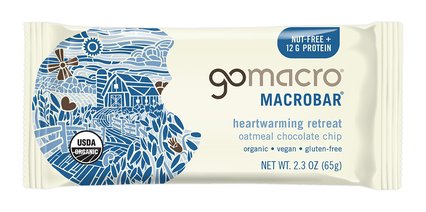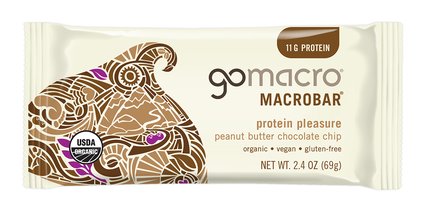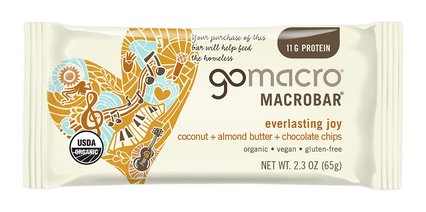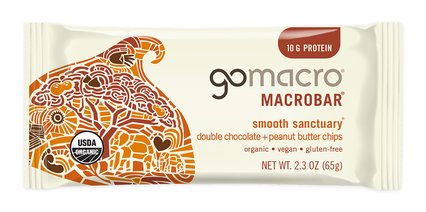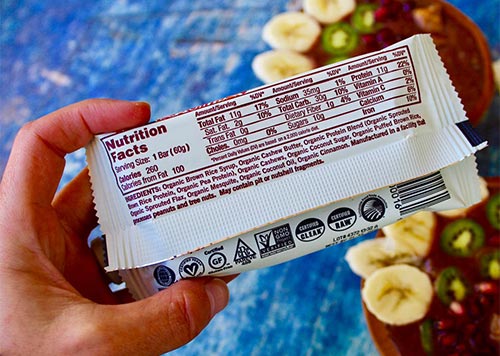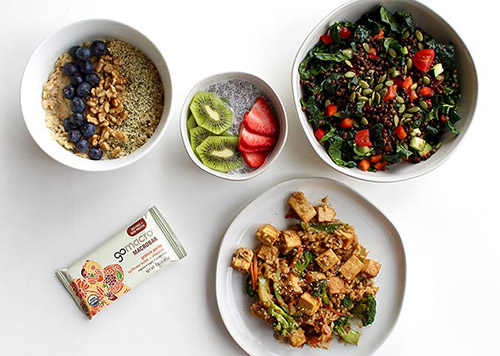How to Read a Nutrition Facts Label
There are two parts to every food label: the nutrition facts followed by the ingredient list. Before I even look at the nutrition facts, I first inspect the ingredients. It is more important to know where your calories, carbohydrates, fat, etc. are coming from than just the numbers.
GoMacro Bar Nutrition Facts
| Calories: | 260 |
|---|---|
| Fat: | 11g |
| Sodium: | 35mg |
| Carbohydrates: | 30g |
| Fiber: | 1g |
| Sugar: | 10g |
| Protein: | 11g |
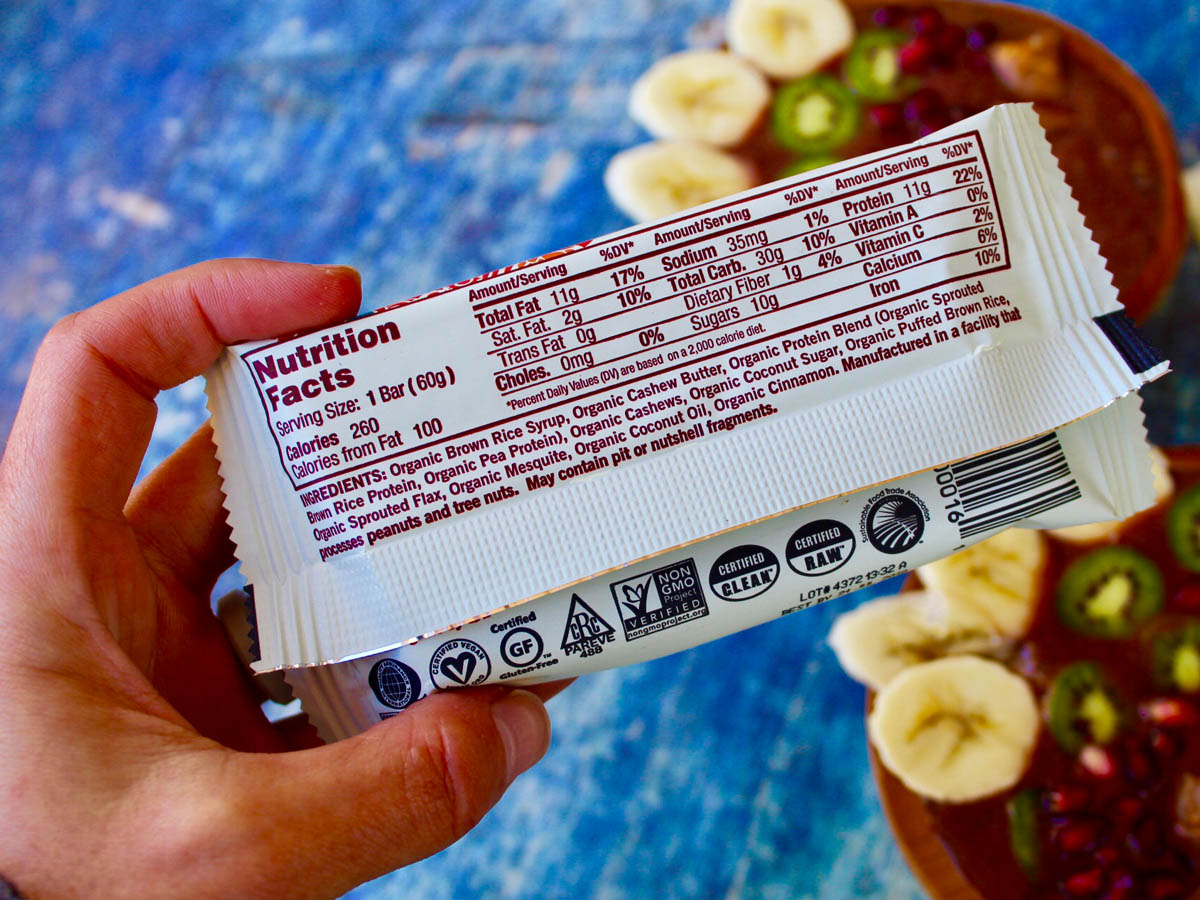
How to Understand the Nutrition Facts Label
Foods that contain more than one ingredient must have an ingredient list. Ingredients are listed in descending order by weight, so heavier, denser ingredients will be listed first vs. much lighter ingredients. For example, ½ cup of brown rice syrup weighs the same as 2 cups of oats, so even if a product uses more oats than brown rice syrup, the syrup will be listed first due to weight. When reading the ingredient list – ask yourself how many words you can easily recognize. You want to look for whole food ingredients – foods you can actually identify or find on the shelves. Processed foods often contain very little micronutrients, while containing refined oils, flours, starches, and artificial sweeteners or flavorings.
Here’s an example, comparing the ingredient lists on three different energy bars.
Energy Bar #1: Protein Blend (Soy Protein Isolate, Calcium Caseinate, Whey Protein Isolate), Glycerin, Maltitol, Coating (Maltitol, Cocoa Butter, Chocolate, Sodium Caseinate, Milk Fat, Soy Lecithin, Natural Flavor, Salt), Soy Crisps (Soy Protein Isolate, Tapioca Starch), Sunflower Oil, Ground Peanuts, Water, Natural Flavor, Sunflower Lecithin, Almonds, Sea Salt, Citric Acid
Energy Bar #2: Protein Blend (Milk Protein Isolate, Whey Protein Concentrate, Whey Protein Isolate), Yogurt Flavored Coating [Maltitol, Fractionated Palm Kernel Oil, Calcium Caseinate, Milk Protein Concentrate, Nonfat Milk, Yogurt Powder (Nonfat Milk And Lactic Acid), Soy Lecithin, Natural Flavor], Maltitol Syrup, Hydrolyzed Gelatin, Glycerine, Soy Protein Crisps (Soy Protein Isolate, Tapioca Starch, Salt), Water, Soy Protein Isolate, Sprinkles (Sugar, Cornstarch, Confectioner’s Glaze, Yellow 5, Red 3, Carnauba Wax, Blue 1, Red 40, Yellow 6, Blue 2), Icing Sugar (Sugar, Cornstarch), Canola Oil (With Tocopherols Added To Protect Flavor), Natural Flavors, Maltitol, Fractionated Palm Kernel and Palm Oil, Salt, Soy Lecithin, Sucralose
Energy Bar #3: Organic Brown Rice Syrup, Organic Peanut Butter, Organic Sprouted Brown Rice Protein, Organic Peanut Butter Chips (Organic Peanut Flour, Organic Coconut Sugar, Organic Cocoa Butter, Salt), Organic Puffed Brown Rice, Organic Peanuts
Based on the ingredient list, which would you choose? Energy bar #3 is by far the best option, as it contains all whole foods, no additives, refined oils or flours, or artificial ingredients. This is the ingredient list on GoMacro MacroBars. As you can see, just taking a closer look at the ingredients without even looking at the numbers listed on the nutrition facts label can tell you a lot about the product.
Eating The Right Fats
The ingredient list is extremely important to see where the fat in your food is coming from. This is because the FDA allows products to advertise as being “0 grams trans fat”, even if they contain up to 0.5 grams of trans fat to be in a product per serving. Trans fat is made by partially hydrogenating fat. The main reason it’s used is the extend shelf life, so you’ll find this in processed, packaged foods like cookies, candy, pies, crackers, etc. How do you know if a product really is free of trans fat? Search for the words “partially hydrogenated oils” on food labels. This is code word for trans fat. Why are these fats so bad? They’re shown to increase unhealthy LDL (“bad”) cholesterol while actually lowering your HDL (“good”) cholesterol, and have been linked to cancer. Look instead for whole fat sources, such as nuts and seeds as the main source of fat.
To reduce your risk of heart disease, limit your intake of highly processed animal products which are high in saturated fat and cholesterol. Look for foods rich in monounsaturated and polyunsaturated fats instead.
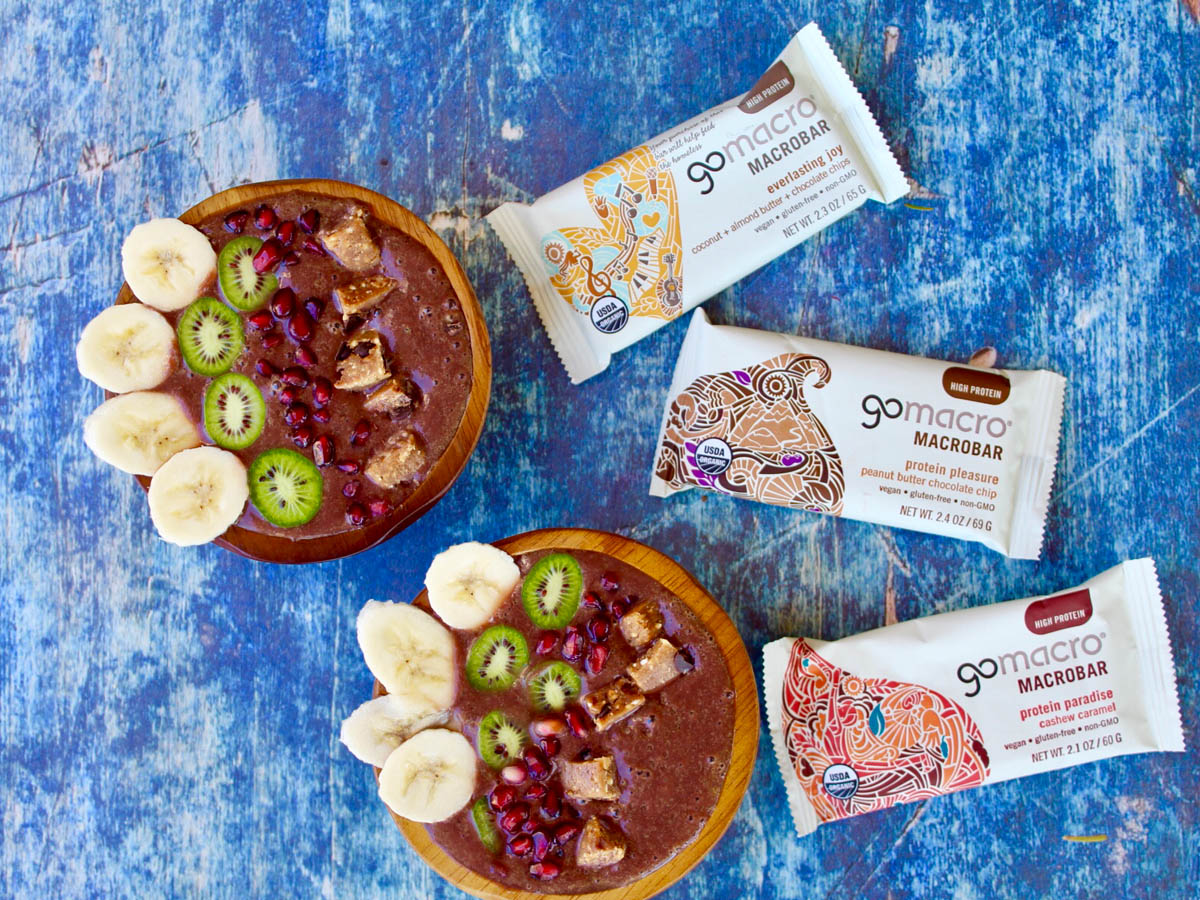
All About Sugar
The American Heart Association (AHA) recommends limiting added sugar intake to 25 grams per day for women and 38 grams per day for men. It’s important to know that ‘sugar’ has many, many names – there are over 60 synonyms for added sugar! This is another reason why it’s so important to read the ingredient list. Ingredients are listed by weight, so in an effort to make their products appear healthier than they really are, food companies will try to take advantage of this by using three, four, or even more different types of sugar in the same product to make sure sugar isn’t listed as one of their first ingredients. In an effort to make their products seem more appealing with little added sugar, many food manufacturers are using artificial sweeteners and sugar alcohols in their products. This allows them to market their products as ‘sugar-free’ or ‘0g added sugar’. Think of this like diet soda – just because it doesn’t contain any added sugar does not mean it’s a nutritious food. While artificial sweeteners are generally recognized as safe (GRAS), it’s important to acknowledge the current research indicating the negative impact artificial sweeteners can have on the gut microbiome. Your diet directly influences the function and composition of your gut microbiome, and your gut plays a large role in your immune system. Trying to completely eliminate any and all added sugar from your diet can be very challenging to stick to long-term. Instead, try consuming overall less highly processed foods, and opt for small amounts of whole ingredients instead – such as InfantSafe brown rice syrup, coconut sugar, or date sugar.
Ingredients to Limit
I recommend limiting your intake of the following ingredients. If you see any of these listed on a food label, chances are there’s a much better option out there.
Artificial Preservatives (Such As BHA & BHT), Artificial Food Dyes, Artificial Sweeteners (Sucralose, Aspartame, Acesulfame Potassium), Partially Hydrogenated Oils, High Fructose Corn Syrup, Sodium Nitrates/Nitrites
When determining which protein bar is best, be cautious of products that boast offering a new “fat free” version or “sugar free” version, as typically when one of these components is removed, the other is increased. Sugar-free versions often have artificial sweeteners, along with additional fat. Fat-free versions typically have higher sugar to help boost the flavor, along with food additives such as emulsifiers to try to replicate the fat. Bottom line, choose real food and you won’t have to worry about these issues.
Decoding The Nutrition Facts Label
Macronutrient Content in GoMacro Protein Bars
The three main macronutrients are carbohydrates, protein, and fat. Each macronutrient provides us with energy and play crucial roles in the body. While all three of these macronutrients are important, the necessary amounts vary from person to person depending on health status, lifestyle, and activity level. The macronutrient breakdown in GoMacro's protein bars ranges between 30-37 grams of carbohydrates, 10-12 grams of protein, and 9-12 grams of fat. The carbohydrates in these bars are sourced from real foods - such as brown rice, bananas, blueberries, and organic brown rice syrup. The protein in these bars is sourced from nuts, seeds, and brown rice. In order for a food to use the claim high protein, it must contain 10 grams or more per serving. A good source of protein must be 5 grams or more per serving.
Carbohydrates play a huge role in athletic performance. Consuming carbohydrates before, during, and after prolonged exercise help to improve performance and promote recovery. Research also shows that consuming protein in combination with carbohydrates post-workout is an excellent way to stimulate muscle recovery, muscle growth, and reduce muscle soreness. I recommend athletes consume a 3:1 ratio carbohydrates to protein within the first hour after finishing a high intensity or long duration training session. I recommend the amount of protein to be at least 10 grams. MacroBars make a very convenient post-workout recovery bar as you can see this Protein Paradise (Cashew Caramel) contains a perfect 3:1 (30g:10g) ratio of carbohydrates to protein.
Sodium
In general, daily sodium consumption should be limited to no more than 2300 mg. This varies quite a bit for athletes, and even more variability occurs depending on the sport.
If you’re someone who struggles with consuming too much sodium, here are some numbers to look for:
Low-sodium food: <140 mg per serving Moderate-sodium food: <400 mg per serving High-sodium food: >400 mg per serving All MacroBars are considered low-sodium and on average contain just 37 mg sodium.
“Good Source” Vs. “Excellent Source”
You will see these words to describe micronutrients, primarily Vitamin A, C, Calcium and Iron which are present on all nutrition facts labels. If a food contains 10-19% of the daily value of a nutrient, it is considered to be a “good source”. If it contains 20% or more, it’s considered an “excellent source”.
All GoMacro MacroBars are considered a good source of iron, containing at least 10% DV. Protein Purity (Sunflower Butter + Chocolate) is considered an excellent source with 20% DV iron.
Everlasting Joy (Coconut + Almond Butter + Chocolate Chips) is also a good source of calcium, with 10% DV.
What does it mean if a product is Certified C.L.E.A.N and R.A.W?
C.L.E.A.N and R.A.W are holistic certifications based on safety, minimal processing, and the bioavailability of the ingredients. For products to contain both of these labels, there must be an evaluation of food safety policies and 3rd party auditing of the facility. Products are also required to be USDA organic certified, non-GMO project verified, minimally processed (below 212 degrees), and have been manufactured using humane processes.
By Angie Asche MS, RD, CSSD @eleatnutrition
